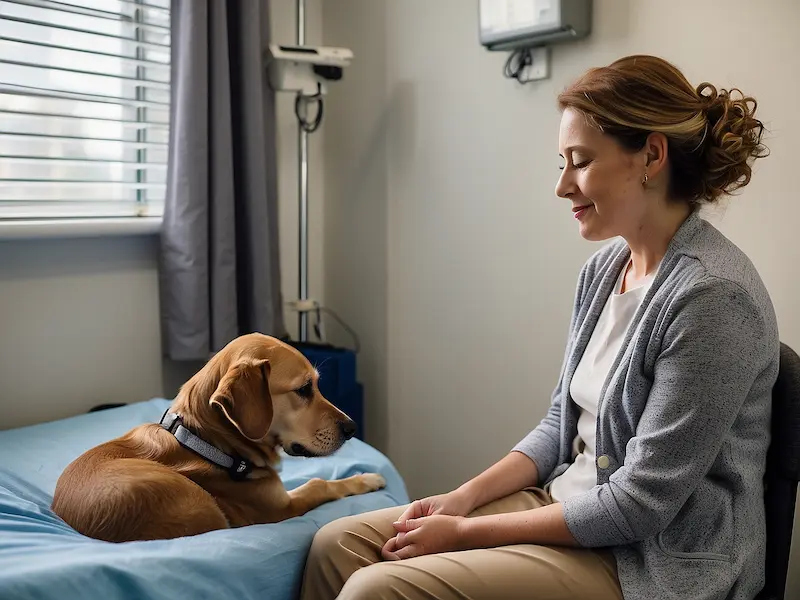Many people rely on therapy dogs and emotional support dogs (ESDs) for comfort, companionship, and mental well-being. While professional training programs exist, some individuals prefer to train their own dogs for these roles. But is it possible? Yes, with dedication and proper guidance, owners can train their own therapy or emotional support dogs.
This guide explores the steps, challenges, and best practices for successfully training your own therapy or emotional support dog.
Understanding Therapy and Emotional Support Dogs
What Is a Therapy Dog?
A therapy dog is trained to provide emotional support and comfort to people in hospitals, schools, nursing homes, and other public settings. These dogs do not have public access rights under the Americans with Disabilities Act (ADA) but can enter facilities with permission to provide therapeutic interactions.
What Is an Emotional Support Dog?
An emotional support dog (ESD) offers comfort and companionship to individuals with mental health conditions such as anxiety, PTSD, or depression. Unlike therapy dogs, ESDs primarily support their owner and do not require specialized training for task performance. However, they are protected under the Fair Housing Act (FHA), allowing them to live in housing that otherwise restricts pets.
Steps to Train Your Own Therapy Dog
Training a therapy dog requires structured obedience training, socialization, and temperament evaluation to ensure the dog is calm and well-behaved in public settings. Here are the key steps:
1. Choose the Right Dog
- Temperament: The best therapy dogs are calm, friendly, and sociable.
- Breed Considerations: Labrador Retrievers, Golden Retrievers, and Cavalier King Charles Spaniels are commonly chosen for therapy work.
- Age and Health: Puppies and young dogs with stable health are ideal for training.
2. Socialization and Exposure Training
- Introduce the dog to different environments, sounds, and people.
- Expose the dog to crowded places, medical equipment, and wheelchairs.
- Ensure the dog is comfortable around children, seniors, and individuals with disabilities.
3. Obedience Training

Basic commands are essential for therapy dogs to behave appropriately in public:
- Sit – The dog sits on command.
- Stay – The dog remains in place.
- Come – The dog returns when called.
- Leave it – The dog ignores distractions.
- Heel – The dog walks calmly beside the handler.
4. Teaching Therapy-Specific Behaviors

- Train the dog to remain calm and focused around strangers.
- Encourage gentle interactions, such as laying beside a person for comfort.
- Train for extended periods of calmness, essential for hospital visits.
5. Certification and Registration
While therapy dogs are not legally required to be certified, many organizations offer evaluations and certifications, such as:
- Therapy Dogs International (TDI)
- Alliance of Therapy Dogs (ATD)
- Pet Partners
Steps to Train Your Own Emotional Support Dog
Since emotional support dogs do not require specialized training, the focus is on ensuring they are well-mannered and responsive to their owner’s emotional needs.
1. Select a Suitable Dog
- Companion breeds such as Golden Retrievers, Poodles, and Shih Tzus are ideal.
- Dogs should be attentive, affectionate, and calm.
2. Basic Obedience Training
Like therapy dogs, ESDs should learn basic commands:
- Sit, Stay, Come, Heel, and Leave it
- Reduce unwanted behaviors such as barking or jumping
3. Training for Emotional Support Behaviors
- Bonding and Sensitivity Training: Strengthen the dog’s ability to detect emotional distress.
- Comfort Responses: Teach the dog to provide physical contact (e.g., laying beside the owner, nudging for comfort).
- Calmness Training: Encourage the dog to remain calm during stressful situations.
4. Understanding Legal Protections
- No Certification Required: Unlike therapy dogs, ESDs do not need certification.
- Housing Rights: Protected under the Fair Housing Act (FHA).
- Air Travel Restrictions: Some airlines allow ESDs, but policies vary.
Challenges of Training Your Own Therapy or Emotional Support Dog
1. Behavioral Issues
- Some dogs may struggle with anxiety, aggression, or excessive excitability.
- Professional trainers can help address these concerns.
2. Public Behavior Expectations
- Therapy dogs must maintain perfect manners in public settings.
- ESDs must behave well in shared housing environments.
3. Finding the Right Trainer
- If needed, seek guidance from a certified dog trainer.
- Use positive reinforcement techniques to encourage good behavior.
Conclusion
Yes, you can train your own therapy or emotional support dog! While therapy dogs require structured obedience and temperament assessments, emotional support dogs primarily need a strong bond with their owner. Selecting the right breed, practicing socialization, and reinforcing positive behaviors are key to successful training.
For therapy dog certification, consider organizations such as Therapy Dogs International or Pet Partners. For emotional support dog legal protections, refer to the Fair Housing Act (FHA).
By following these steps, you can ensure your dog becomes a reliable and loving support companion.








